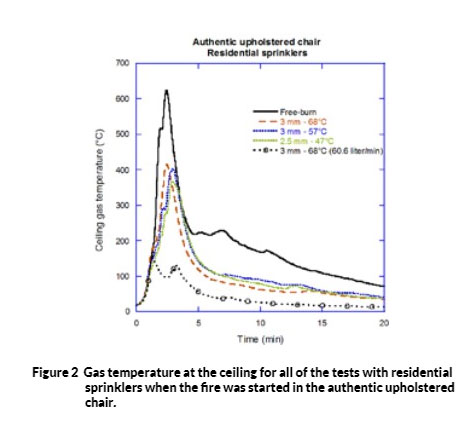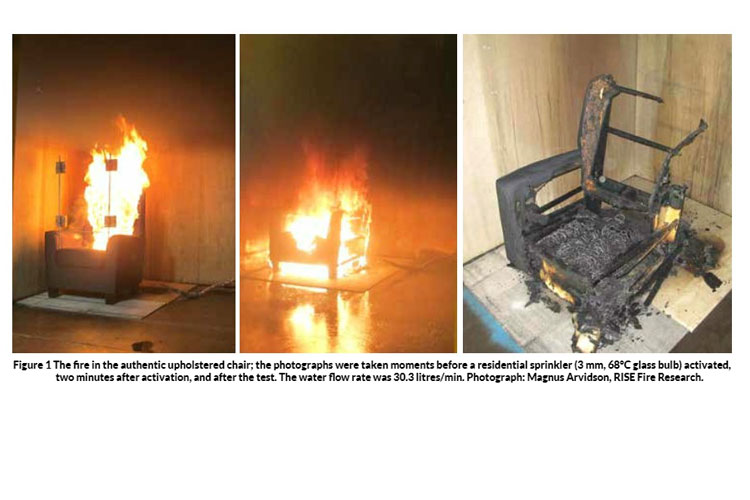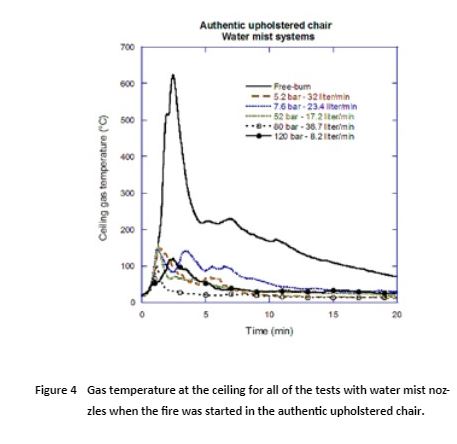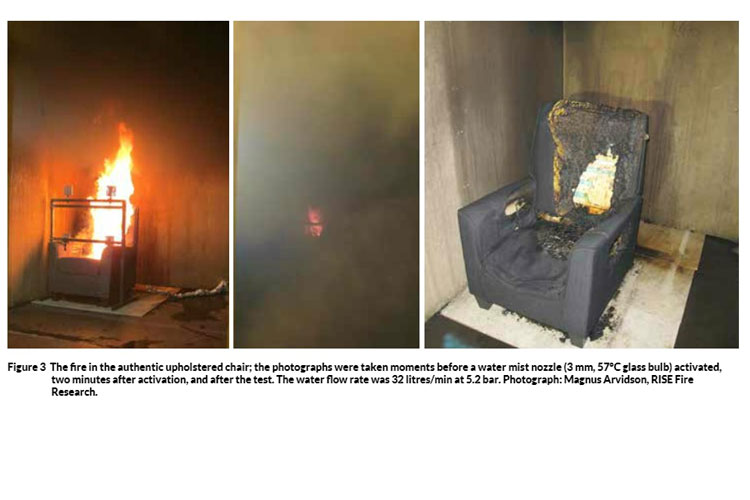
Source: RISE
In Sweden, domestic fires cause approximately 90 fatalities annually. Although the probability of perishing in a domestic fire has decreased when the issue is viewed from a long-term perspective, the number of fatalities has been roughly constant over the last few decades, despite the introduction of smoke alarms and, in recent years, fire-safe cigarettes, mobile sprinkler systems, and stove guards.
Residential sprinklers were developed in the USA in the early 1970s, and data from there and other countries suggests that residential sprinklers reduce the fatalities, injuries, and damage inflicted by (and thus cost of) domestic fires. The technique was introduced in Sweden at the beginning of the 2000s, and has been a requirement in newly built sheltered accommodation and hospitals since 2012. Fixed water mist fire protection systems that have a potentially lower water flow rate are alternatives to traditional residential sprinklers. In recent years, mobile sprinkler systems have been increasingly used to improve fire safety in existing living environments in which there is a heightened need for fire protection; these include the homes of the elderly, heavy smokers, those with dementia, and disabled people in care homes or home environments. In a number of documented cases mobile sprinkler systems have prevented fatalities in fires; no studies, however, have been conducted to explore their effect on Swedish statistics.
Improved efficiency through earlier activation?
RISE has performed a series of fire tests with traditional residential sprinklers, as well as several different types of water mist nozzles and a mobile sprinkler system. The primary objective was to investigate whether it is possible to improve the efficiency of traditional residential sprinklers if they are activated earlier during a fire. This was achieved using a glass bulb with a lower thermal inertia (lower RTI) and lower activation temperature than are normally used to activate the sprinkler. The secondary objective of the tests was to investigate the efficiency of nozzles that emit ‘water mist’. These nozzles were also activated by a glass bulb, which in turn was activated by the heat of the fire. The mobile sprinkler system that was tested was activated by a fire detection system (smoke and heat), which contributed to a somewhat earlier activation of the system.
Simulated and real-world upholstered chair fires
The tests were conducted in an analogue of a small domestic room, and the fire sources used were a strongly simplified replica of an upholstered chair and an authentic one, purchased from a furniture company. In order to evaluate the efficiency of the fire protection system, the surface temperature of plate thermometers positioned in front of the fire test source and gas temperatures (at the ceiling directly above the fire and at eye-level inside the test rom) were measured. In addition, the concentration of carbon monoxide (CO) was measured at a specific point in the test room. In order to obtain reference values, free-burning tests were also performed for both fire scenarios.
The test room was 3.66 × 3.66 m with a ceiling height of 2.5 m. This corresponds to 12 ft. × 12 ft., which is the smallest area of coverage for residential sprinklers listed by Underwriters Laboratories Inc. The test room had an ordinary doorway in one of the walls.

Modest improvements in efficiency through earlier activation
The results show that earlier activation of residential sprinklers contributes to a somewhat improved efficiency for a sprinkler water flow rate of 30.3 litres/min (corresponding a to 2.05 mm/min discharge density). The relatively modest improvement in efficiency is likely due to the water flow rate of the sprinkler being too low to suppress the fire at the point of activation. Figure 1 shows one of the tests using the authentic upholstered chair, in which the flow of the domestic sprinkler was 30.3 litres/min.
This hypothesis is supported by the significant improvement in efficiency when the water flow rate from the residential sprinkler was doubled to 60.6 litres/min. A higher water flow rate partially reflects conditions in reality, insofar as the water flow rate is higher when the first sprinkler of a system is activated. In addition, the water flow rate corresponded to a water discharge density of 4.1 mm/min used for taller residential buildings and operations in which residents require assistance in evacuating. Figure 2 shows the gas temperature at the ceiling for all of the tests with residential sprinklers when the fire was started in the authentic upholstered chair.
Residential sprinklers were developed for different types of housing with the practical objective of preventing flashover, thus inhibiting the development of critical conditions and so creating a larger window for evacuation. The tests show that a residential

Photograph: MAGNUS ARVIDSON, RISE FIRE RESEARCH
sprinkler makes the environment in a room that is on fire survivable, at least at a certain distance from the fire source. In the immediate vicinity of the fire source, high surface temperatures (high heat flux) of the plate thermometers were registered and both the replica and authentic chairs sustained severe fire damage, regardless of the flow rate of the residential sprinkler.
Significant improvements in efficiency through water mist nozzles
The water flow rate of the water mist nozzles varied between 17.2 and 36.7 litres/min, and the water flow rate of the mobile sprinkler system was 8.2 litres/min.
A significantly improved efficiency in terms of a more reduced fire and lower gas temperatures at the ceiling above the fire and in the test room was achieved using the water mist nozzles and mobile sprinkler system. The same or better performance was achieved using roughly half the amount of water of the residential sprinkler. However, the fire damage to both the replica and authentic upholstered chairs was so extensive for all water mist nozzle tests that it is doubtful whether a person in the immediate vicinity of the fire would survive. Figure 3 shows one of the tests with water mist nozzles and the authentic upholstered chair as the fire source. The nozzle that was tested had a 3 mm, 57°C glass bulb and a water flow rate of 32 litres/min at 5.2 bar, which was comparable to that of the test of the residential sprinkler presented in Figure 1, but the performance was significantly better.

A subjective observation from the tests was that a fire in a real, commercially available upholstered chair is surprisingly rapid and intense, even for a relatively small ignition source. The time taken for a domestic room to fill with smoke and a fire to reach the flashover point is short. Residential sprinklers and other, alternative fire protection systems thus fill an important role in reducing the consequences of a fire.

Photograph: MAGNUS ARVIDSON, RISE FIRE RESEARCH
Figure 4: Gas temperature at the ceiling for all of the tests with water mist nozzles when the fire was started in the authentic upholstered chair.
More information is available in SP Report 2017:40
In 2010, the Swedish Civil Contingencies Agency (MSB) adopted a zero vision regarding serious injuries and fatalities as a result of fire in Sweden. As most fire fatalities in Sweden relate to domestic fires, reducing their incidence is of great importance. An initiative to achieve this is the MSB’s call for proposals for research funds of 2014. Three proposals to this call were approved, one of which was the ‘Analysis of fire safety physical determinants and technical measures to decrease the number of casualties in residential fires’ project, in which the technical factors that may have an impact on the number of fatalities in domestic fires are identified, along with potential solutions.
The tests described here were conducted within the framework of this project, and are presented in detail in RISE Report 2017:40, ‘An evaluation of residential sprinklers and water mist nozzles in a residential area fire scenario’.
RELATED
RISE Research Institutes of Sweden, Efectis Group Sign Memorandum of Understanding
RISE Report Examines Risks for Alternative Fuels in Road Tunnels, Underground Garages

